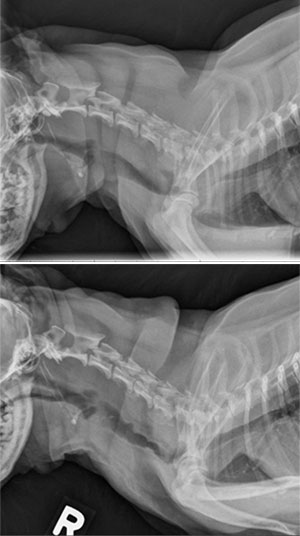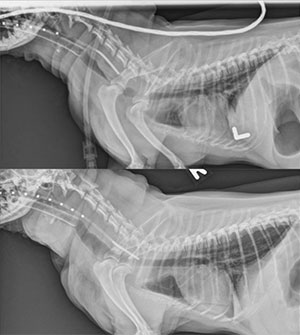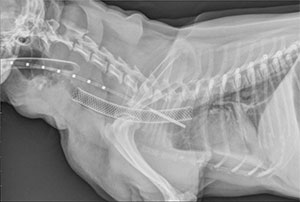



When Sophie, a seven-year-old Yorkshire terrier, was brought into the Lloyd Veterinary Medical Center at Iowa State University on Christmas morning, the veterinarians on call thought it would take a miracle for the dog to survive.
It might not have been a miracle but things broke in just the right way for Sophie to continue with a normal and productive life.
“When Sophie arrived at our ICU she was in full respiratory distress and was actually turning blue,” said Dr. Jaron Naiman, a small animal surgical resident at Iowa State. “She was nonresponsive to sedation or oxygen therapy and we had to perform an emergency intubation on her.”
Sophie’s history with the Lloyd Veterinary Medical Center in the College of Veterinary Medicine began back in 2012 when she was first diagnosed with respiratory issues. Her tracheal collapse was treated with the insertion of six extraluminal rings into the tracheal area. This ailment is common among small dog breeds but Naiman says it is rare to see a case as severe as Sophie’s.
The dog remained stable for the next three years without medications until this past summer, when the rings that had been inserted into her began to weaken and collapse. Medication was prescribed and she responded favorably to the treatment until the early morning hours of Christmas Day.
Her breathing became so labored that her Fairfield, Iowa, owners decided to brave the snowy Christmas morning conditions to drive the two plus hours to Ames, arriving around 6 a.m. to one of the few veterinary hospitals open 24/7 in Iowa.
Naiman was on call when Sophie arrived and soon was overseeing her treatment. For five hours, teams of Lloyd Veterinary Medical Center staff members manually ventilated the Yorkie until she was stable enough to take her into surgery.
“Everyone was ventilating the dog,” said Dr. Scott Christopher, a small animal surgical resident who was also on call Christmas morning. “Someone was sitting next to her the entire time we were trying to stabilize her.”
Sophie’s luck continued when not only was Dr. Louisa Ho-Eckart, assistant professor of veterinary clinical sciences, in town on the holiday, but the previous summer she had attended a seminar and learned how to perform this particular surgery. The surgery was an intraluminal tracheal stent placement, a minimally invasive surgery with no incision. Ho-Eckart said this procedure was used because the trachea was collapsed further down in Sophie’s chest cavity and only a stent could reach into the chest cavity.
“This was actually the first time I had done this surgery,” Ho-Eckart said. “Bigger metropolitan areas like New York City do it all the time, but we just don’t get the case numbers for this here in Iowa.”
Sophie was stabilized and a surgeon had been found with a working knowledge of the required procedure. But Sophie’s next challenge relied solely on inventory stock at the Lloyd Veterinary Medical Center.
The procedure Ho-Eckart elected to perform on Sophie required an intraluminal tracheal stent. But one size does not fit all dogs, especially a small Yorkshire terrier.
“We (the Lloyd Veterinary Medical Center) hadn’t used these stents in a while,” Christopher said. “We didn’t know if we had the right size or not so I got on the phone calling all the area referral hospitals to see if we could find one and get it here quickly.
“We even considered having Sophie’s owners drive up and back to the University of Minnesota to get the stent. Thankfully we found what we needed in our own inventory.”
With everything now in place, Ho-Eckart performed the surgery with Naiman and Christopher assisting.
“Every surgery is nerve-wracking,” Ho-Eckart said. “This time I had to be very precise because if the stent had been too big or too short, that would have caused a big problem.”
In the end everything worked out just right. Sophie quickly responded to her treatment and is well on her way to recovery.
“Just a few hours earlier, I didn’t know if she was going to make it,” Ho-Eckart said. “But when she woke up from surgery it was like she was totally fine again and we were able to release her two days later.
“Everything fell right into place thanks to our great team and their dedication. This was a true Christmas miracle.”
